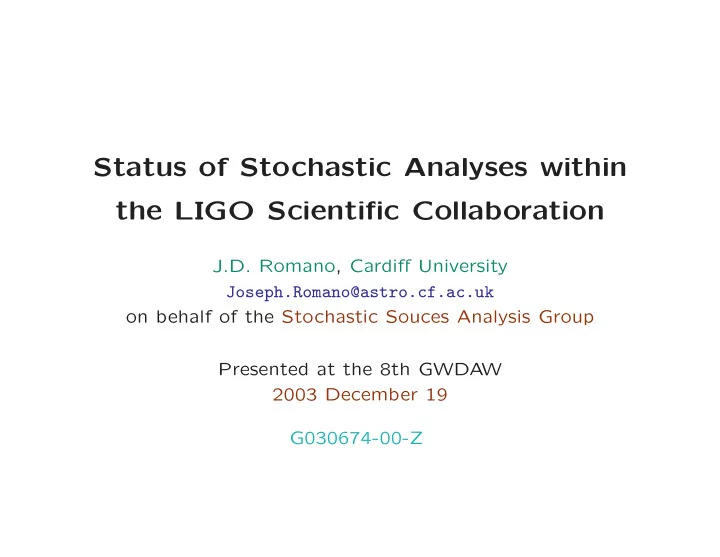

Status of Stochastic Analyses within the LIGO Scientific Collaboration J.D. Romano, Cardiff University Joseph.Romano@astro.cf.ac.uk on behalf of the Stochastic Souces Analysis Group Presented at the 8th GWDAW 2003 December 19 G030674-00-Z
Outline • Introduction • S1 Analysis • S2 Analysis – Preliminary results – Refinements under consideration • Parallel projects – ALLEGRO-LLO, GEO-LIGO stochastic analyses • S3 Preview – E10 coherence
Introduction • Set upper limit on a stochastic background Ω gw ( f ) = Ω 0 • Use standard optimally-filtered cross-correlation method: � � � s ∗ s 1 ( f ) ˜ Y ≡ dt 2 s 1 ( t 1 ) Q ( t 1 − t 2 ) s 2 ( t 2 ) ≈ f ˜ Q ( f )˜ 2 ( f ) dt 1 d • Science runs: – S1: August - September 2002 – S2: February - April 2003 – S3: November 2003 - January 2004 • Analysis to date has focused on LIGO-LIGO correlations • Extend analysis to include ALLEGRO-LLO, GEO-LIGO
S1 Analysis • Paper almost submitted to gr-qc • Improves direct broadband and narrow band upper limits • Freq range: 40-314 Hz (LLO-LHO), 40-300 Hz (H1-H2) • Observed instrumental correlations between H1-H2 • GEO data not included in the analysis IFO Pair Obs time Estimate Error bar Upper limit Ω 0 h 2 100 ≤ 55 ± 11 H1-L1 64 hr 32 18 Ω 0 h 2 H2-L1 51.25 hr 0.16 18 100 ≤ 23 ± 4 . 6 H1-H2 100.25 -8.3 0.95 —
S2 Analysis • Preliminary analyses underway (search parameters not final) • Preliminary upper limits ∼ 1000 times better (as expected from improved sensitivity and longer observation) • H1-H2 still dominated by instrumental correlations • Refinements to the analysis pipeline—to be discussed • Verifying/validating new version of LDAS code against S1 code & injected signals (K. Reilly) • Analyze together with S3 data before writing up
Key quantities • CC statistic values: � s ∗ s I 1 ( f ) ˜ Y I = f ˜ Q I ( f )˜ I 2 ( f ) d • Optimal filter: � − 1 γ 2 ( f ) �� γ ( f ) ˜ Q I ( f ) = N I N I ∝ d f f 3 P I 1 ( f ) P I 2 ( f ) f 6 P I 1 ( f ) P I 2 ( f ) • Theoretical variance: � − 1 γ 2 ( f ) �� σ 2 I ∝ d f f 6 P I 1 ( f ) P I 2 ( f ) • Weighted avg of CC measurements & error bar: I σ − 2 � Y I 1 σ 2 I Y opt = opt = I σ − 2 I σ − 2 � � I I
Possible S2 Pipeline Enhancements • High-pass filtering: – To reduce spectral leakage from low-frequency seismic noise consider time-domain hi-pass filter • Overlapping Hann windows: – Replace (flat top) Tukey windows with Hann windows for better leakage protection – Non-overlapping Hann windows lose 50% of effective obs time; overlapping windows recover almost all of this • Combining measurements from multiple IFO pairs: – How to combine H1-L1 and H2-L1 given instrumental cor- relations in H1-H2? (See Lazzarini/Whelan talk) • Monte Carlo simulations: (S. Bose, T. Regimbau) – Many long weak injections to check weak-signal limit to determine detection efficiency – Signals now continuous in time-domain (spliced IFFTs)
Parallel projects 1. GEO-LIGO correlation: • Coherence measurements to access data quality • Stand-alone search code: (A. Mercer) – 2-3 hours for S2 analysis at B’ham (200 nodes) – Validation/verification against LDAS code, injections – Monte Carlo simulation capability (T. Regimbau) – Handles calibrated and uncalibrated data • Hardware injections to be implemented in future 2. ALLEGRO-LLO correlation: See Whelan’s talk
S3 Preview: E10 Coherence (40–201 Hz) E10 H1-H2 coherence lower than S2 despite reduction in PSD. Most stringent S3 limit from H1-H2?
S3 Preview: E10 Coherence (200–361 Hz)
S2 Preliminary Data Analysis Pipeline Detector #1 data Detector #2 data clean, contiguous, coincident data Decimate to Decimate to 1024 s/sec 1024 s/sec divide into 60-sec divide into 60-sec segments segments PSD estimate PSD estimate (0.25Hz BW) (0.25Hz bins) window window zero pad calibrate calibrate zero pad Frequency FFT FFT mask theoretical Optimal variance σ I Filter cross correlation statistic Y I Y optimal error bars (best estimate of Ω T)
Recommend
More recommend